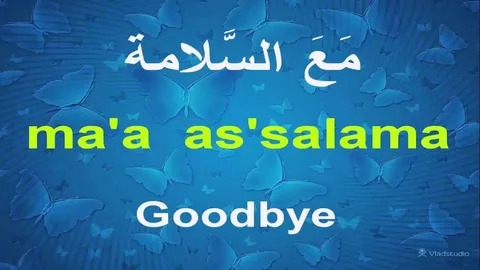Last Updated on December 30, 2024 by Arabian Tongue Team
In our diverse world, languages serve as a window into different cultures. One of the most beautiful aspects of language is how it encapsulates the essence of a culture, from its values to its emotions. Arabic, a rich and complex language, is no exception. In this article on Arabian Tongue website, we will explore the various ways of saying goodbye in Arabic, delving into the linguistic intricacies and cultural nuances that make each phrase unique.
Understanding the Importance of Goodbyes

Before we dive into the linguistic journey, let’s understand why goodbyes matter. Saying goodbye is not just a formality in Arabic culture; it is a reflection of respect, warmth, and connection. It signifies the end of an encounter and leaves a lasting impression.
Recommend: Allahumma Ameen
The Arabic Language
The Arabic language is known for its elegance and depth. It is written from right to left and has a unique script that flows gracefully. Arabic is not just a means of communication; it’s an art form.
Regional Variations, Arabic is not a monolithic language; it has regional variations. Different regions have their unique ways of saying goodbye.
Salaam
“Salaam” is a word that transcends borders. It is a universal greeting and also a common way to bid farewell. “As-salaam alaykum” means “peace be upon you” and is used to say goodbye with good wishes.
Cultural Significance, Arabic culture places immense value on politeness and hospitality. Goodbye phrases often reflect this.
Ma’a Salama
“Ma’a Salama” means “go with safety.” This phrase carries a heartfelt wish for a safe journey or a safe return home.
Wada’an
In Egypt, “Wada’an” is commonly used. It means “goodbye,” but it’s more than just a farewell; it’s an expression of hope to meet again soon.
Read more: Subhan Allah meaning
Goodbye with Gestures
In Arabic culture, words are not the only way to say goodbye. Gestures play a significant role.
Hugs and Cheek Kisses, In many Arab countries, it’s customary to exchange hugs and cheek kisses when saying goodbye to friends and family. It’s a warm and affectionate way to part. Handshakes, For more formal settings, handshakes are the norm. A firm and respectful handshake signifies a sincere goodbye.
Why Learn Arabic Goodbyes?
Understanding how to say goodbye in Arabic not only demonstrates respect for the local culture but also opens doors to meaningful connections. Whether you’re a tourist, a language enthusiast, or someone who interacts with Arabic speakers regularly, these parting phrases can help you leave a positive impression.
Read about: Mashallah Tabarakallah meaning
Common Arabic Farewell Phrases

Here are some common ways to say goodbye in Arabic, ranging from formal to informal:
1. مع السلامة (Ma’a al-salama)
Meaning: “Go with peace.”
Usage: Formal and respectful, suitable for most situations.
2. وداعًا (Wada’an)
Meaning: “Farewell.”
Usage: Appropriate for formal occasions and showing respect.
3. إلى اللقاء (Ila al-liqaa)
Meaning: “Until we meet again.”
Usage: Friendly and suitable for both formal and informal settings.
4. إلى الليل (Ila al-layl)
Meaning: “Until tonight.”
Usage: Commonly used when parting in the evening.
5. سلام (Salaam)
Meaning: “Peace.”
Usage: A casual and friendly way to say goodbye.
6. متى نلتقي مرة أخرى؟ (Mata naltaqi marra ukhra?)
Meaning: “When will we meet again?”
Usage: A warm way to express the desire to reunite.
Informal and Colloquial Farewells
In addition to the formal phrases mentioned above, Arabic has a wealth of informal and colloquial farewells that vary by region and dialect. Here are a few examples:
7. بالسلامة (Bi-salaama)
Meaning: “In safety.”
Usage: Commonly used among friends and acquaintances.
8. روح وجيبلي (Rouh w-jebli)
Meaning: “Go and bring me.”
Usage: Playful and friendly, often used among close friends.
9. مع الأيام (Ma’a al-ayam)
Meaning: “With the days.”
Usage: An optimistic and hopeful farewell.
Etiquette Tips
When using Arabic farewell phrases, keep these etiquette tips in mind:
- Respect Formality: Use formal expressions when addressing elders, superiors, or in professional settings.
- Smile and Maintain Eye Contact: A warm smile and eye contact can enhance the sincerity of your farewell.
- Handshakes or Hugs: Depending on the level of familiarity, a handshake or a hug may accompany the goodbye.
- Learn Local Variations: Different Arabic-speaking regions may have unique parting expressions, so it’s useful to adapt to local customs.
HOW Arabian tongue shapes your journey of Learning Quran and arabic?
At Arabian Tongue, we empower you with the tools that allow for reflecting on the meanings of the Quran and sensing the greatness of the Creator. We incorporate unique teaching methods in our courses listed below:
- Learn Quran Online
- Online Arabic Classes
- Learn Tagweed Online
- Arabic grammar course online for beginners
- Quran Ijazah Course for Kids
FAQs
Is Salaam the most common way to say goodbye in Arabic?
Yes, Salaam is a widely used and respectful way to say goodbye in Arabic.
Are there variations in saying goodbye in different Arabic-speaking countries?
Yes, there are regional variations in goodbye phrases and customs across Arabic-speaking countries.
What is the significance of cheek kisses when saying goodbye in Arabic culture?
Cheek kisses are a sign of affection and warmth when bidding farewell to friends and family.
How important are gestures when saying goodbye in Arabic culture?
Gestures, such as hugs, cheek kisses, and handshakes, hold significant importance in expressing sincerity when saying goodbye.
What should I keep in mind when saying goodbye in an Arabic-speaking country?
Respect, warmth, and politeness are key. Using appropriate phrases and gestures is a way to show your appreciation for the culture.
Conclusion
Saying goodbye in Arabic is more than just words; it’s a reflection of the culture’s values and traditions. Whether it’s the universal “Salaam” or the heartfelt “Wada’an,” each phrase carries with it the warmth and respect that define Arabic culture.
So, the next time you bid farewell in Arabic, remember the beauty of the language and the culture it represents. It’s not just a goodbye; it’s a connection.

